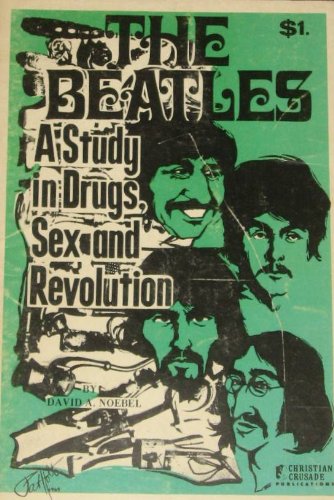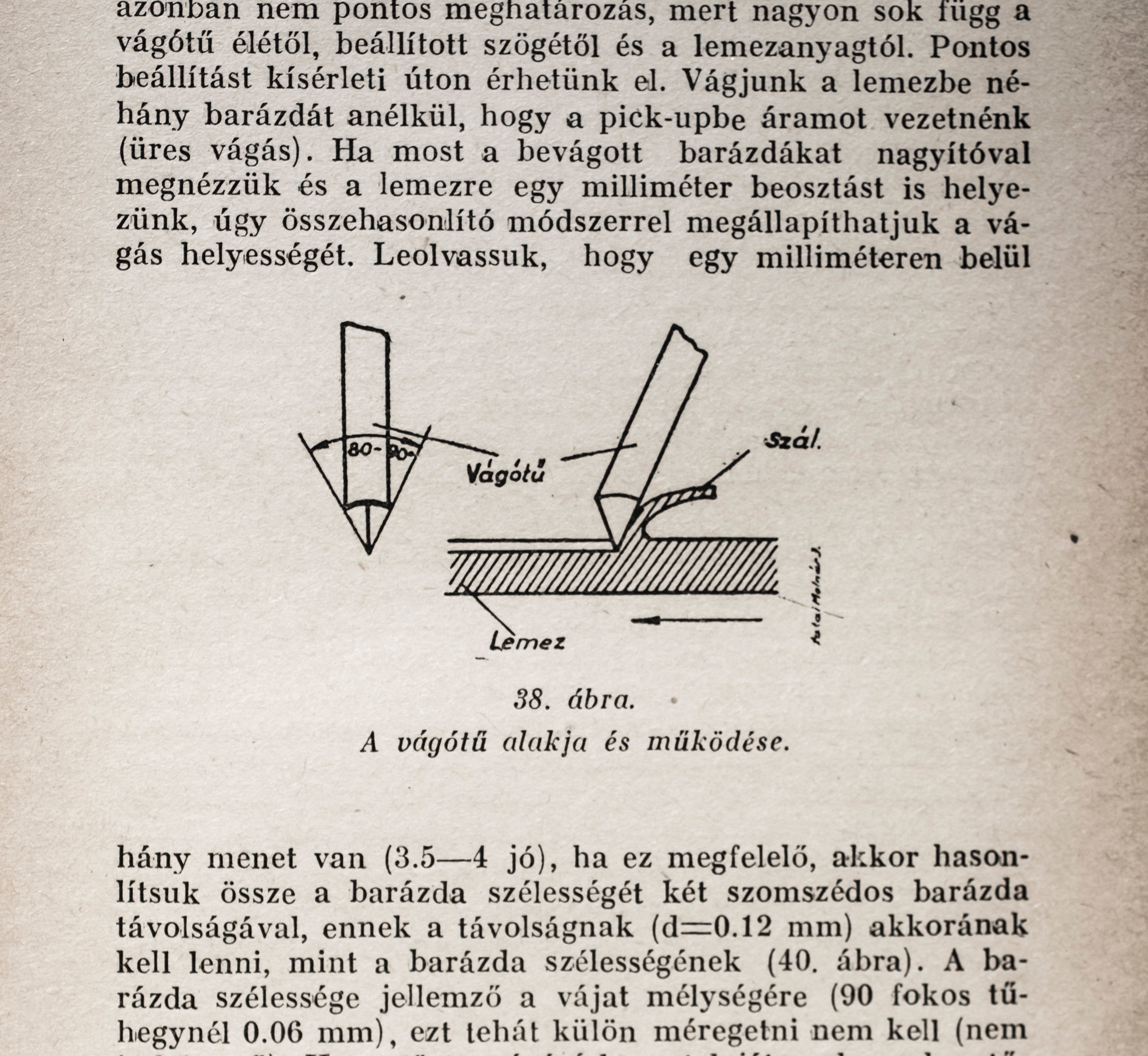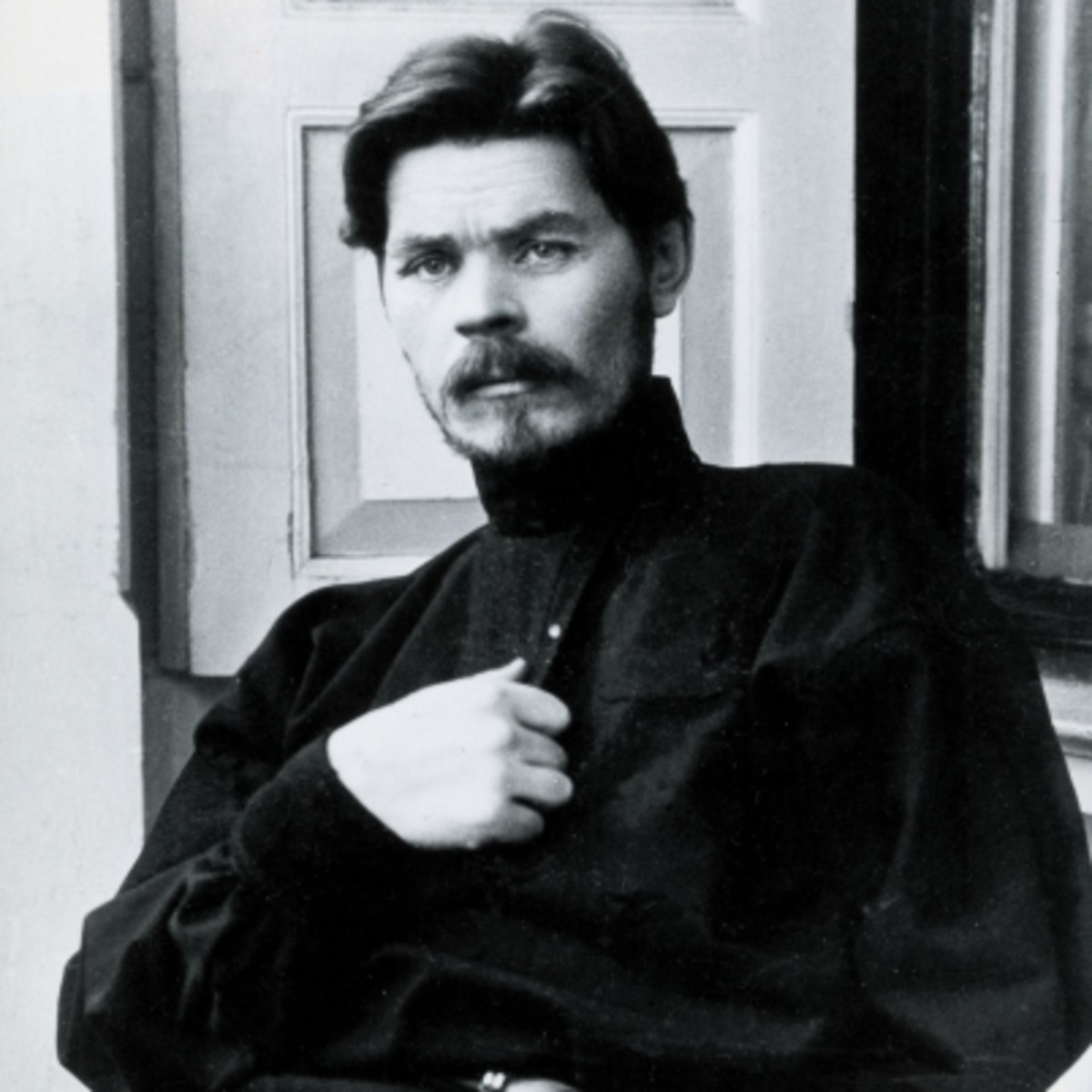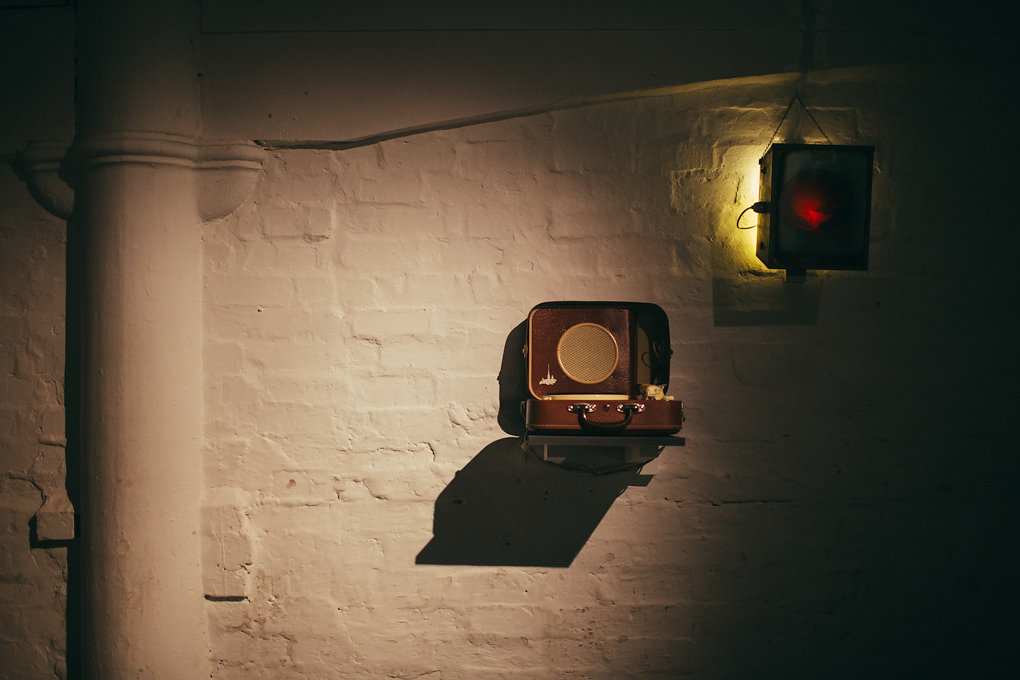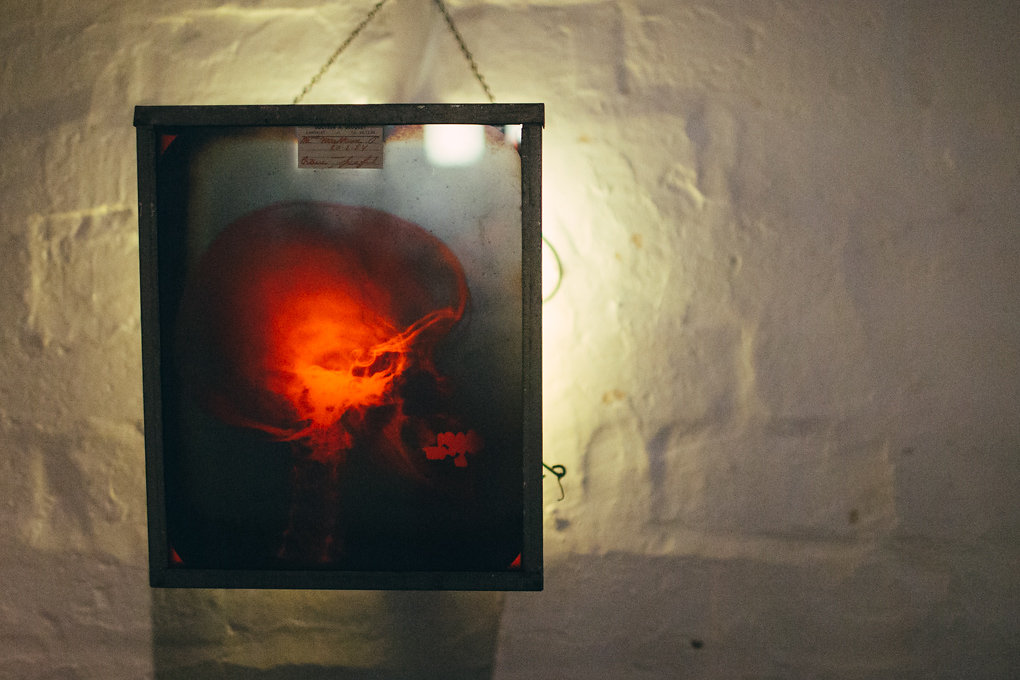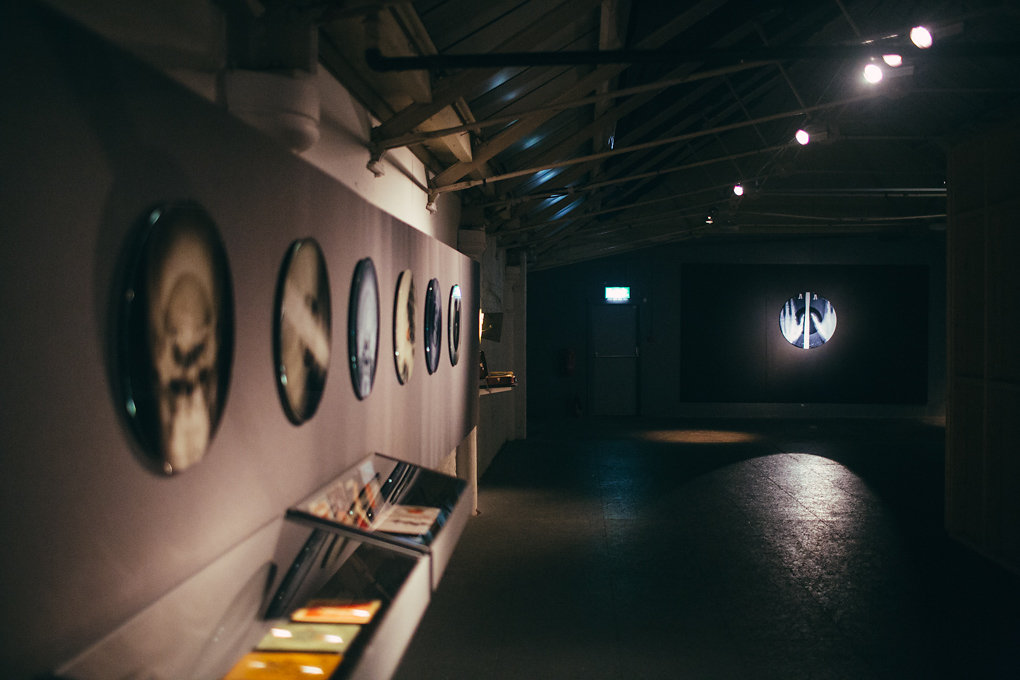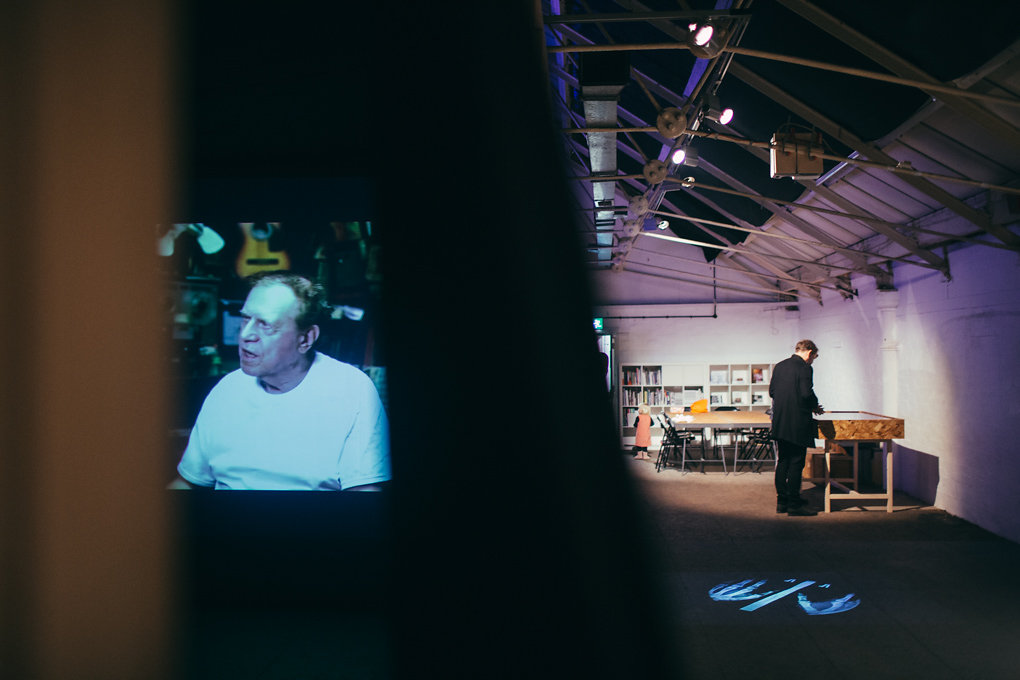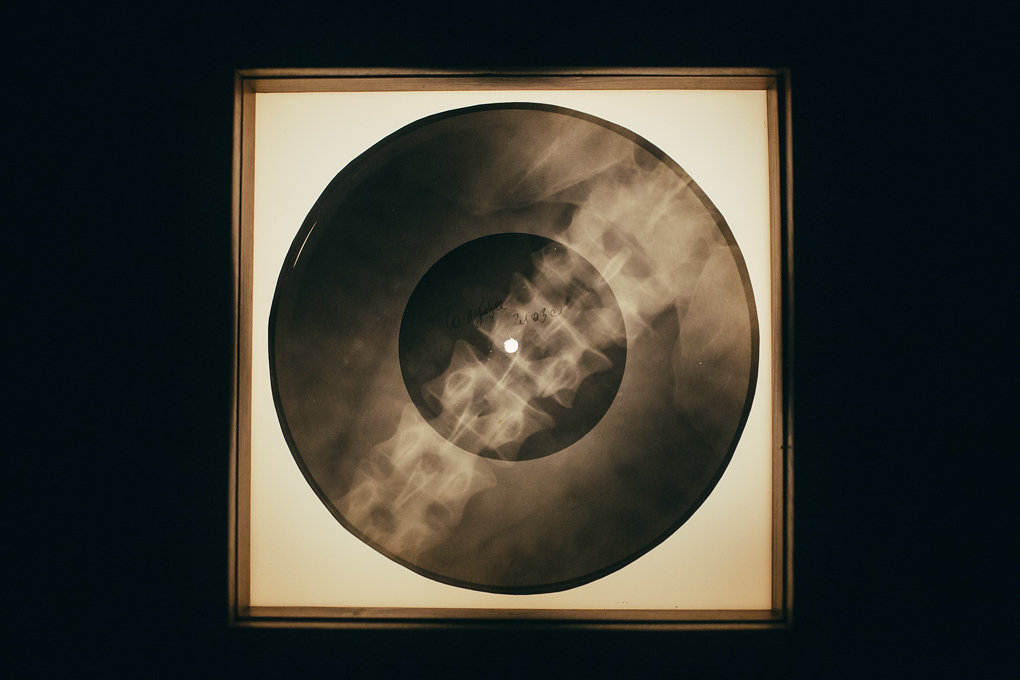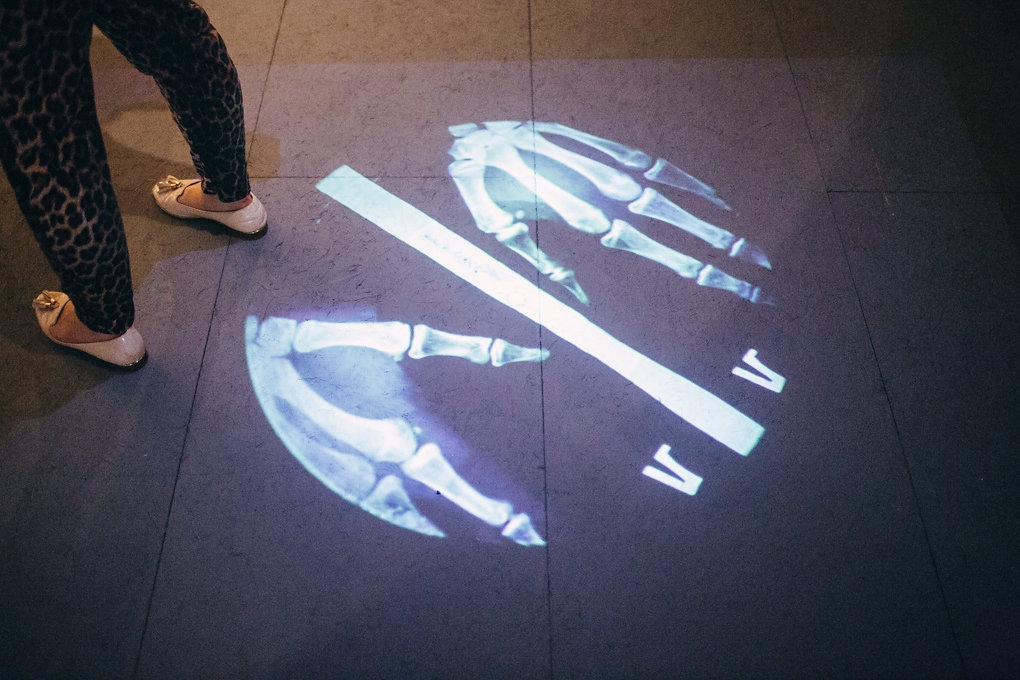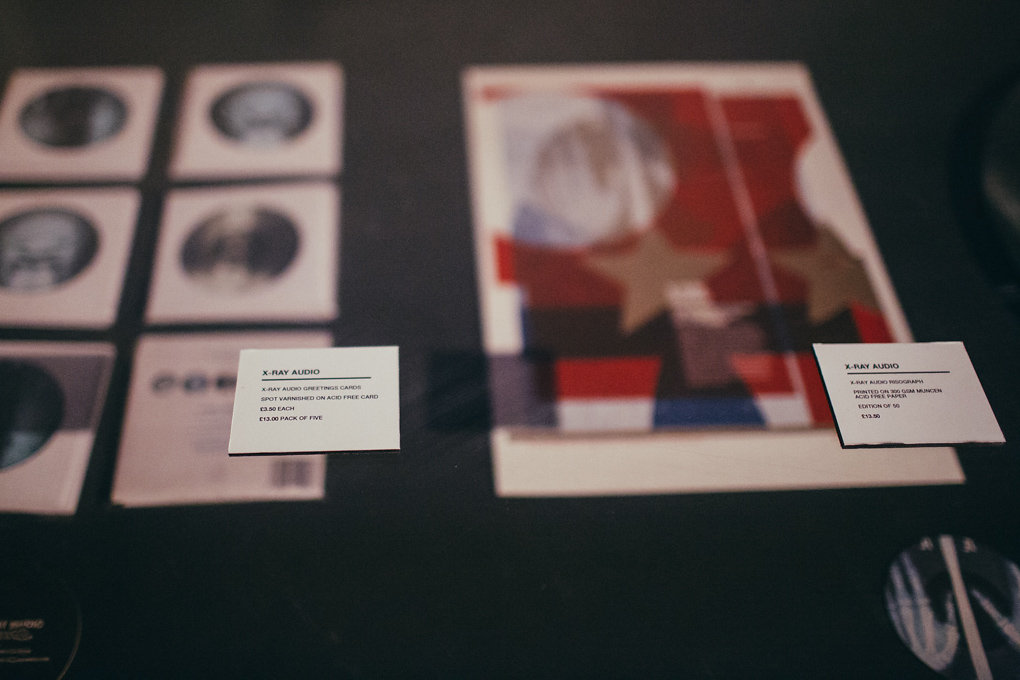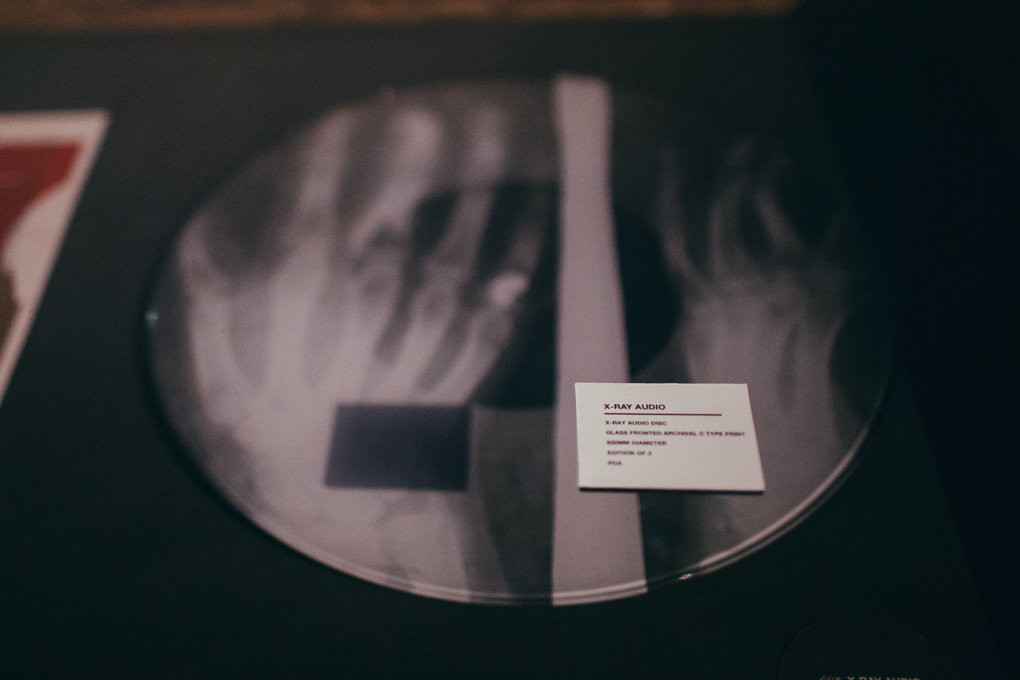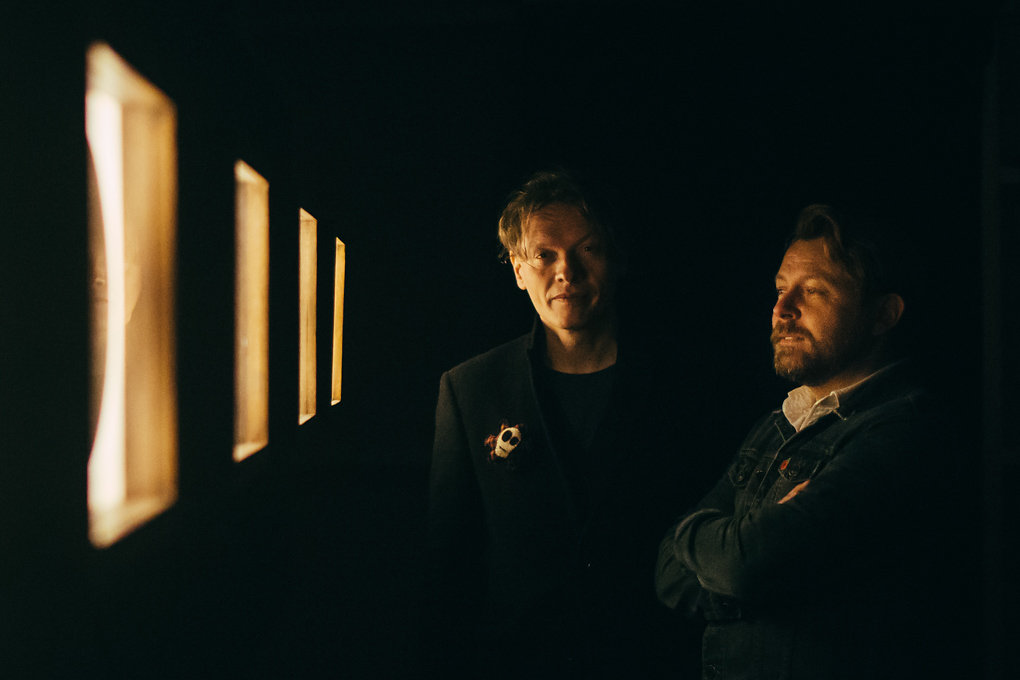Marx looks on disapprovingly as a Stilyagi (hipster) dances on a pile of Jazz records
Communism, Hypnotism and The Beatles
So You Say You Want a Revolution?
It’s easy to be comically outraged by the abusive, and at times menacing, attitude of the Soviet Authorities toward the young Russian hipsters known as Stilyagi who aped American fashions. They were really just fun-seeking kids, not dissidents, but they were regularly pilloried in the press, as was the Western Jazz and Rock and Roll they loved to listen to on x-ray records. But it’s worth remembering that in the West too there were similar disapproving attitudes towards teenagers, ‘hooligans’, ‘delinquents’, young ‘punks’ etc.. Rock ‘n’ Roll was described as ‘the devil’s music” using much the same pseudo- moral reasons given in the atheist Soviet Union: that it had ‘sexual rhythms" and "suggestive lyrics", that it would tempt the young and innocent off the path of virtue and into acts of depravity or social disobedience. Elvis Presley, whose music drew a huge amount of ire from conservative quarters, and who was subject to various prohibitions at times, is STILL being censored in the US it seems.
This moral disapprobation of young, cool music collided with the rampant anti-communist rhetoric of the American fundamentalist right with almost comical effect from the 1950s to 1970s. Firebrand Christian writer David Noebel* (who is still active) published various books and leaflets warning against the infiltration of the Reds into the US. He claimed the Communists were using pop music to brainwash young people. Obvious left-wing folkies such as Joan Baez and Pete Seeger first attracted his righteous indignation but he was convinced that Bob Dylan, The Beatles and particularly John Lennon, were also intent on corrupting American youth - and were being used deliberately by the Soviets to do so.
He may perhaps have assumed that the fact the Soviet authorities prohibited these and similar artists (such as the Russian ‘bard’ singers), was not evidence that their music was actually anti-totalitarian, but proof of its fundamental moral degeneracy - and therefore of its efficacy in attacking the West. What he felt about the fact that the US and the British, were actively broadcasting such corrupting music into the Soviet Union, and aiming it specifically at young people, is difficult to know.
What would he have made of our recently deceased friend Kolya Vasin, the Russian ‘Beatles Guy’? As a youth, Kolya had all the outward signs of a 1960s rebellious teenager: the long hair, the hippy clothes, the acoustic guitar and the afternoons spent drinking wine in the park. He suffered as a result - he was ridiculed and even assaulted by members of the Komsomol youth police at various times.
Early in the 1960s he had bought an x-ray record which had turned out to contain a Beatles song. It changed his life profoundly, in fact it made him pro - US and anti-communist. When I asked him what The Beatles music meant to him, he simply said one word: ‘Freedom’.
It seems fundamentalist thinking, whether it be on the left or the right, always seems to feel threatened by youth and pop culture, in fact by …freedom.
*Some of David’s books (and a vinyl LP) are above and below.
The anti rock ‘ n’ roll propaganda could get quite nasty. As in the Soviet Union, it was sometimes underpinned with a vicious racist narrative - with black culture in the US seen as responsible, gypsy and jewish influences blamed in the USSR.
Watch this selection for more.
They Knew About X-Ray Records in 1950s America
….And about the young Russian hipsters known as ‘Stilyagi’ - or ‘Soviet Zoot Suiters’ as they called them.
The Sound of the Modern X-Ray Record
At X-Ray Audio live events we cut new x-ray records from live performances. We have worked with various musicians playing in different styles including the thereminist Lydia Kavina, Marc Almond, Barry Adamson, Marcella Puppini, Alexander Hacke (Einstürzende Neubauten), Thurston Moore (Sonic Youth), Veronika Harcsa, Nadia (Race for Space) and Mobius.
To cut the records, we use a 1950s MSS recording lathe (see below), originally used by BBC journalists in the field. This was the kind of machine copied by the Soviet Bootleggers to make their records.. Modern X-Rays are much more difficult to cut onto than the cellulose nitrate based radiography film used in the 1930s - 1960s. They made of a nylon based plastic and are much harder.
The original bootleggers got some surprisingly good sonic results cutting on very thin film with sapphire needles using homemade machines like the one here to the right. They also often had great taste and, sometimes (and somehow) access to cool records. Mikhail Farafanov, a bootlegger we interviewed last year, took pride in introducing his customers to the new sounds he discovered and loved - as well as selling them the popular tunes they asked for. He also took pride producing the best audio quality he could, whereas some of his rivals were happy to pass off very poor sounding records on gullible people who were just keen together their hands on any forbidden music at all.. We came across various stories of unfortunate punters buying a record and discovering it was not what they had asked for or was virtually unlistenable when they got it home.
Here is an example of a great sounding late 1950s /early 1960s bootleg recording of a rare rock ‘n’ roll record ‘Big Guitar’ by an unknown artist (if you know who it is, please let us know). It is still sounding hot after all these years I think you will agree.
A recording lathe is a little like a gramophone / record player in reverse. Instead of a needle that ‘reads’ the groove of a record through vibrations which are transformed and amplified into sound, a vibrating cutting head scratches a groove into a blank spinning surface when an audio signal is fed into it. Particularly when it comes to using x-ray film as the media rather then commercially available acetates, the process is a bit like cooking and somewhat unpredictable even if you have the recipe. There are lots of variables that make a difference: the age of the cutting needle, the angle of the cut, the temperature, the surface quality, the type of music, the skill of the recordist, the quality of the original source etc.. Each record is cut in real time, so each sounds different than all the others. We learned the process by actually doing it and from details we learned from an 1930s technical manual we found in Budapest.
Below are a selection of digitised clips from records made with some the artists we have worked with.
Barry Adamson at The British Library
Audio hi fi quality obviously isn’t the point and they are a tough listen at times but they do have a rather wonderful ghostly quality which we have come to love. All the musicians have worked with have been delighted - even if not with the quality, then with the magic of making a record so directly (and a strange beautiful one at that) without the intervening layers of management, record company, pressing plant and even sound engineer..
Death of a Bone Buyer
A couple of months ago, we learned of the death of KOLYA VASIN. Kolya was famous in Russia as 'The Beatles Guy' or as he liked to describe himself: 'The Number One Beatles Fan'.
We met him several times - usually in 'The Temple of Love' - a crazy, crowded couple of rooms in St Petersburg which he had set up as a shrine to the Fab Four - and specifically to John Lennon who he regarded almost as a deity. We interviewed him for our book and documentary and last saw him at the X-Ray Audio exhibition in St Petersburg a year ago.
When Kolya was young in Leningrad in the 1960s he was introduced to Western Rock and Roll - on x-ray records. He immediately became addicted and spent all his money (including cash his mother gave him for school lunch) on buying them. One day he brought home a disc and played it. It was The Beatles and it is no exaggeration to say that it completely changed his life. From that time forward he devoted himself to their music.
He told us what it was like to be a young music lover in the oppressive years of the Soviet Union and about the culture of getting the music he loved from dealers on the street. A lot of the information about the punk street culture of the x-ray dealers came from Kolya. Essentially buying x-ray bootlegs then was like buying illegal soft drugs now - and it ran the same sort of risks and punishments.
In some ways Kolya was crazy - or at least very eccentric - but he was a genuinely good person, a free spirit: he believed in love, freedom and the transformative power of rock 'n' roll. He was living testament to the liberating power of music - and it all began for him with x-ray records. His death was tragic - it seems he finally gave up on his dream of having a permanent shrine to Lennon in St Petersburg for some reason and he then found no reason to go on living.
He ended his life by jumping from a building.
You can watch him in the video below unhappier times as he tells of his life as a youth in Soviet Leningrad and how he was affected by the discovery of music on X-Ray
RIP Kolya.
Totalitarian Jazz
Jazz is one of the Western styles which appear on Bone Records and of course was the most popular one amongst the youth group The Stilyagi but the complex story of Jazz in the Soviet Union cannot be easily summed up. The party line on it varied considerably through the decades from the relatively tolerant 1920s to the brutal era of the late 1940s. (The best book on the subject is probably S. Frederick Starr's Red and Hot: The Fate of Jazz in the Soviet Union 1917-1991 ).
Attitudes hardened and became much more punitive after writer and Socialist Realist ideologue Maxim Gorky published his piece "The Music of the Gross" in 1928.
Maxim Gorky
"There are rumblings, wails and howls like the smarting of a metal pig, the shriek of a donkey, or the amorous croaking of a monstrous frog. Bestial cries are heard, neighing horses, wild screaming, hissing, rattling, wailing, moaning, cackling. The insulting chaos of insanity pulses to a throbbing rhythm. Listening to this screaming music for a few minutes , one involuntarily imagines an orchestra of sexual maniacs led by a man-stallion beating time with an enormous phallus. The monstrous bass belches our English words; a wild horn wails piercingly, calling to mind the cries of a raving camel; a drum pounds monotonously; a nasty little pipe tears at ones ears; a saxophone emits its quacking nasal sound. Fleshy hips sway, and thousands of heavy feet tread and shuffle. The music of the degenerate ends finally with a deafening thud, as though a case of pottery had been flung down from the skies."
In Gorky's inflamed rhetoric, it is difficult to separate out any objection to the specific styles and sounds of jazz from a general prejudice against Western music or music which made young people want to dance or have sex rather than work. Improvisation and complexity were of course frowned on as being 'formalistic' and judged as being incomprehensible to the common man or woman.
But at different times, jazz was tolerated - particularly the more polite, light, cocktail styles - and of course there were some noted Soviet Jazz musicians or musicians who played in more swing styles such as Eddie Rosner**. During the second world war, when the US , Britain and the Soviet Union were allies, it was even possible to watch American films with jazz soundtracks in Moscow and St Petersburg and to hear Western tunes on the radio, a brief period of detente which provoked the hunger for such music in a subsequent generation of young music lovers. But later there were again brutal repressions with musicians being pulled from stages and imprisoned. Rosner himself spent time in a Gulag was lucky to survive.
Strangely, it seems totalitarian regimes from all ends of the political spectrum have shared similar objections to jazz. According to Czech writer and dissident Josef Skvorecky, a tenor saxophone player living in Third Reich-occupied Czechoslovakia, the Nazis took a similar line to the Soviet ideologues. In the introduction to his novel The Bass Saxophone, he recalls ten regulations issued by a certain Gauleiter, a Nazi official, to control the performance of the local dance orchestras during the Czech occupation:
Eddie Rosner
- Pieces in foxtrot rhythm (so-called swing) are not to exceed 20% of the repertoires of light orchestras and dance bands;
- In this so-called jazz type repertoire, preference is to be given to compositions in a major key and to lyrics expressing joy in life rather than Jewishly gloomy lyrics;
- As to tempo, preference is also to be given to brisk compositions over slow ones so-called blues); however, the pace must not exceed a certain degree of allegro, commensurate with the Aryan sense of discipline and moderation. On no account will Negroid excesses in tempo (so-called hot jazz) or in solo performances (so-called breaks) be tolerated;
- So-called jazz compositions may contain at most 10% syncopation; the remainder must consist of a natural legato movement devoid of the hysterical rhythmic reverses characteristic of the barbarian races and conductive to dark instincts alien to the German people (so-called riffs);
- Strictly prohibited is the use of instruments alien to the German spirit (so-called cowbells, flexatone, brushes, etc.) as well as all mutes which turn the noble sound of wind and brass instruments into a Jewish-Freemasonic yowl (so-called wa-wa, hat, etc.);
- Also prohibited are so-called drum breaks longer than half a bar in four-quarter beat (except in stylized military marches);
- The double bass must be played solely with the bow in so-called jazz compositions;
- Plucking of the strings is prohibited, since it is damaging to the instrument and detrimental to Aryan musicality; if a so-called pizzicato effect is absolutely desirable for the character of the composition, strict care must be taken lest the string be allowed to patter on the sordine, which is henceforth forbidden;
- Musicians are likewise forbidden to make vocal improvisations (so-called scat);
- All light orchestras and dance bands are advised to restrict the use of saxophones of all keys and to substitute for them the violin-cello, the viola or possibly a suitable folk instrument.
Gorky would have approved.
** Adolph Ignatievich Rosner, also known as Eddie Rosner (1910 - 1976) was a Polish and Soviet Jazz musician called "The White Louis Armstrong". This is in part because of his rendition of the St. Louis blues. He also served as a prisoner in the Gulag prison camp in the former Soviet Union under Joseph Stalin." Wikipedia
Yves Montand and The Bones of Bremen
We were very pleased to be contacted recently by Manuela Putz at The Research Centre for East European Studies * at the University of Bremen with regard to various x-ray records in their archive.
The records are part of the personal papers of the Polivanov-familiy and were donated by the philologist Anastasia Alexandrovna Baranovich-Polivanova (born 1932). They have an interesting Samizdat connection and musical history.
Courtesy of Research Center for East European Studies, Bremen, F. 01-137
Anastasia’s husband, the mathematician Michail Konstantinovich Polivanov, was active in samizdat circles and she is the daughter of Marina Kazimirovna Baranovich, a member of the underground Soviet Anthroposophical Movement, who helped to publish early samizdat works by authors such as Antoine St. Exupery. Study of anthroposophy, a mystical philosophy founded by Rudolf Steiner, was made illegal in the Soviet Union in 1923 and subsequently many Russian practitioners ended their lives in the gulag. The movement remained underground until the more open climate of the 1970s.
Courtesy of Research Center for East European Studies, Bremen, F. 01-137
The music on the discs is by French-Italian singer and actor Yves Montand. The first time Anastasia heard Montand’s music was at a "French evening“ (she was studying languages) at the Moscow State University around 1954/55. She was able to obtain an actual original Montand vinyl album but it was stolen in 1957 - such records would be very desirable and valuable. She was unable to find a replacement but a generous and resourceful friend somehow managed to find Montand songs recorded on x-ray and presented them to her as a consolatory gift.
Courtesy of Research Center for East European Studies, Bremen, F. 01-137
Montand and Signoret in the film "Yves Montand sings" a documentary about the singer's 1957 Russian tour.
Yves Montand is an interesting case in relation to x-ray bootleg culture. Under the influence of his wife Simone Signoret he had become part of the radical crusading French left in the mid-1950s and both he and Signoret were subsequently feted in Moscow. He performed concerts there to great acclaim and the couple even spent time debating freedom with Khruschev.
Given that, and the cultural ties between the Russia and France, his repertoire did not fall prey to the Soviet censor in the way that other Western music did - well, not until he become a critic of the USSR's foreign policy after the invasion of Hungary and the execution of Imry Nagy in 1958.
Program for Yves Montand's Moscow concerts 1957
As such, these x-ray discs may be examples of more conventional 'bootlegs' - that is, privately made copies of records that were, or had been, officially available but were expensive or difficult to find.
The rather beautiful unusual picture disc below containing the song 'A Paris' is also from the Research Centre's archive and is an interesting one. It is obviously not an x-ray but is an example of one of the other types of film used to create privately-made bootlegs - in this case, the music is cut onto the printers' photographic film used in the making of the cover of a book. We have come across several records made using this kind of film - which, like x-rays, must have been suitable for holding the grooves of music written using a recording lathe.
Image Courtesy of Research Center for East European Studies, Bremen, F. 01-137
* During the years of the Eastern Bloc, censorship and repression, The Research Centre for Eastern European Studies acted as a depository of cultural memory for dissenters and members of the opposition in Eastern Europe. Documents from the Soviet Union, Poland, Czechoslovakia, Hungary and the GDR arrived in Bremen via various routes.*
The Research Centre came to be a place of refuge for dissidents and their work in spite of the Iron Curtain. As a result, during the 1980s, the Research Centre concentrated on manifestations of independent artistic activity and intellectual creativity in the underground. It looked for the unofficial streams and dissenting thoughts behind the facade of official politics that gave a view into the internal workings of these societies.For more information on the work of the centre go HERE
JUDY GARLAND ON BONE
A correspondent from Moscow, Anton Rodin, kindly sent in this image of a rather beautiful bone record he has found. It contains the song SEND MY BABY BACK TO ME by Judy Garland singing with Paul Weston and his Orchestra and originally recorded in 1953 and released as a 45rpm 7 inch single by Columbia Records in the US.
Unfortunately like many bone records the disc is too deteriorated to digitize properly but you can listen to the original song HERE. It is an interesting choice for an x-ray bootleg, quite happy but a bit more showtune in style than most of the copied Western songs which tended to be straight rock 'n' roll or swing.
Thanks to Anton.
STILYAGI
The Stilyagi, ‘style hunters’ or followers of fashion as we might say, were a small youth culture group (the only real Soviet youth culture group according to Art Troitsky), mainly Moscow and Leningrad based kids who dressed in an ersatz western style and aped American and British mannerisms. Like any youth subculture, they tried to use clothes and music as a way to identify themselves as separate to their more conventional peers and the values of the older generation. They made up a section of the audience for x-ray bootlegs but were only interested in Western Jazz and Rock and Roll. Their style evolved but settled around a cartoonish version of the British Teddy boy or ‘Grease’ era US 50s rock ‘n’ roll look.
The first reference to them as an actual group was a derisory piece in the satirical magazine Krokodil in 1949: "The most important part of their style is not to resemble normal people. And as you see, their efforts take them to absurd extremes. The stilyaga knows the fashions all over the world.. He's studied all the fox trots, tangos, rumbas, lindy hops in detail, but he confuses Michurin with Mendeleev, and astronomy with gastronomy... they flutter above life's surface, so to speak"
Over the next years, they were regularly lambasted in the press for being vacuous, vain, lazy, only interested in dancing or clothes and unappreciative of Soviet culture. There may have been some truth in those accusations - even some bootleggers who sold them x-ray records seemed to have found them a bit silly - but, as is often the way, the cartoon images that were published in the press have, to modern eyes, the opposite effect to that intended - that is, they actually make the Stilyagi look quite cool - certainly a lot cooler than the upright worthy Komsomol Soviet youths that were held up as being their moral superiors. You can't help wondering if the artists drawing the cartoons were perhaps a little bit 'Stilyagi' themselves?
In fact, the attention the press gave the Stilyagi probably rather pleased them and even the name 'Stilyagi', became a badge of honour. The had their own argot: they called Nevsky Prospekt 'Broadway'; they called each other American names like 'Bob', 'Bud' and Eddie'; they designed and made their own clothes, adapting curtains to make highly patterned ties and wide trousers; they chewed gum made of paraffin wax; they had their hair cut into elaborate ostentatious quiffed styles.
But they were rebels without a cause, more like hipsters than punks for although they are sometimes portrayed as bravely taking on the might of the Soviet establishment, they weren't really political at al. They weren't persecuted as dissidents and It wasn't an imprisonable offence being a Stilyagi, although they did sometimes suffer at the hands of the Komsomol and other disapproving citizens. There are stories of their hair being forcibly cut, skinny trousers slashed, kipper ties snipped by scissors.
But being the target of bullying and the butt of satirical cartoons didn't have that much effect - just in the way that propaganda and punishment did not stop people making x-ray records. No, what really dd for the Stilyagi was when, bowing to the inevitable, the authorities gave permission for an international youth festival to take place in the late 1950s. Lots of foreigners including many young Americans came to Moscow. The Stilyagi were shocked and embarrassed to see that the people and fashions they had been devotedly trying to follow had moved on. They realised they looked out of date and faintly ridiculous in comparison with the real thing.
Subsequently, there seems to have been a split with some of the old guard sticking with the more rock and roll style and younger people migrating towards a more Beat and then Hippie look in the 1960s. But it's apparent that in the more relaxed and consumer friendly atmosphere of Khruschev's 'Thaw' period, fashionable styles became more integrated in young people's clothing generally.
Krokodil carried on with its rather wonderful parodies. These images and later ones of stylish young people well into the early 1970s, take the moral line that stye concious youngsters were parasitic, living it up at the expense of their long suffering and hard-working parents - but then of course that was an accusation that was simultaneously being made of kids in the West.
The X-Ray Audo exhibtion at Garazh the museum of contemporary Art in Moscow in August will feature a gallery of various of the satirical cartoons of Stilyagi from Krokodil.
CUTTING THE (BBC) BONE
Although techniques for building a device capable of making home-made records were known about in the Soviet Union before the war, they were strictly for the highly knowledgeable amateur with considerable engineering skills. The Leningrad bootleggers really got going after a Polish refugee, Stanislav Philo, turned up in 1946 with a war trophy, a Telefunken recording lathe. He used it to make copies of forbidden records and Ruslan Bugaslovsky of the Golden Dog Gang was able to copy the machine itself to make his own records and subsequently further machines.

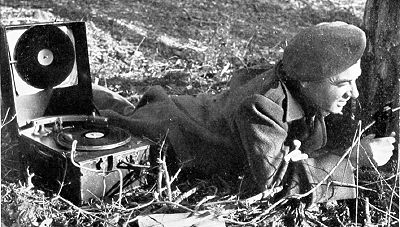


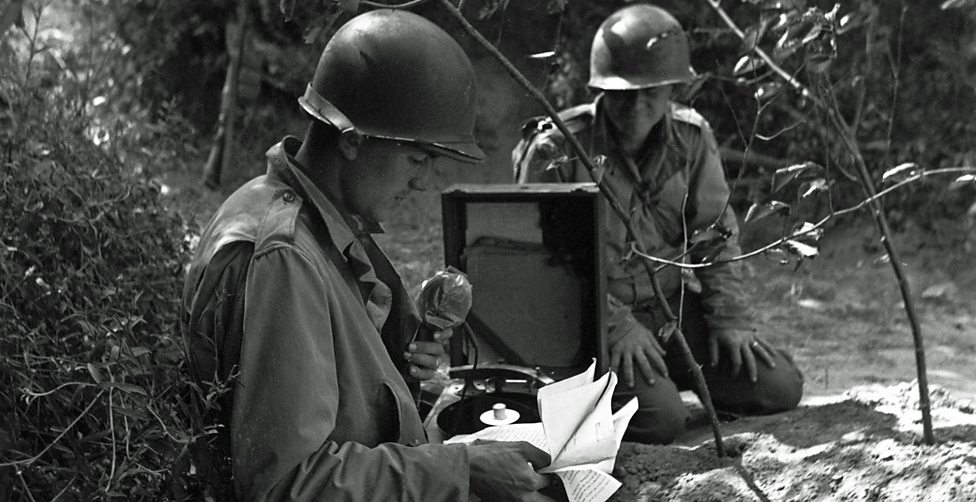
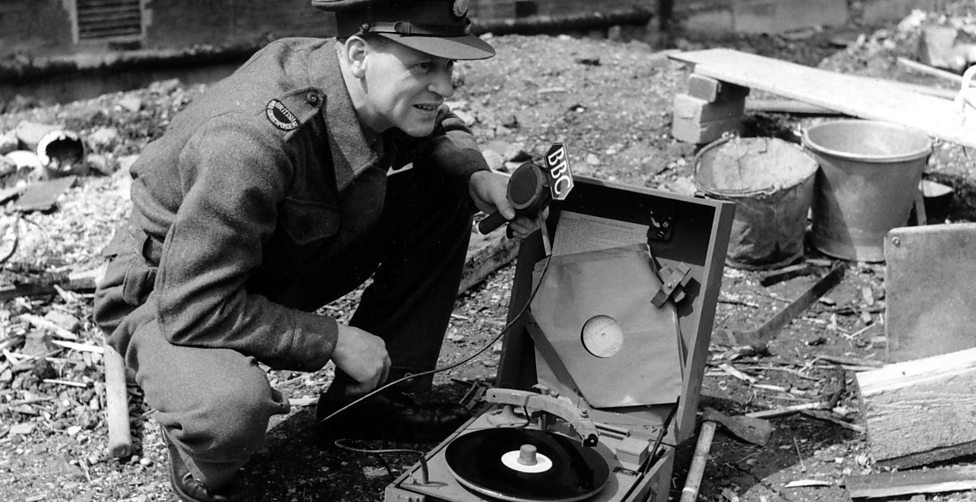
The Telefunken machine was designed to be a portable (or at least 'transportable') machine to be used by war reporters in the field. The American and British also issued these type of machines to journalists and military personnel to make recording on proprietary discs of various sorts. Above are some wonderful photographs courtesy of the BBC of the 'Midget' recording lathe in action.
Here at X-Ray Audio, we have been fortunate to be able to get hold of our very own 1950s lathe - an "MSS" - a later alternative to the Midget which was also used extensively by the BBC.
Currently being refurbished by the amazing Norman Field, we are hoping to take it on the road to cut x-rays and other one-off records later in the year.
THE TRAGIC STAR OF THE BONE UNDERGROUND
On the bone records that survive, the most of music is Russian. Some of it could be called Soviet jazz or jazz-influenced but a great deal could not. Much of it was the repertoire of émigré artists like Pyotr Leshchenko, a singer who might be described as 'the star of the Bone underground', as his music features on x-ray records more than any other artist. Listening to it now, the haunting, romantic melodies, old-fashioned rhythms and sometimes dramatic, sometimes innocuous lyrics don’t seem ‘anti–Soviet’. So why would it have been forbidden?
There were two reasons: firstly Leshchenko was a traitor as far as the Soviet regime were concerned because he was considered to be a ‘White’ Russian émigré of noble blood. In fact he was born into a Ukrainian peasant family but by living in the West he was tarnished by association with the capitalist oppressor, and by not returning to the Motherland to help the Great March Forward, he effectively set himself beyond the pale. Secondly, he performed in styles which had increasingly became prohibited as Stalin increased the cultural stranglehold after the Second World War: the ‘gypsy’ romances and flamboyant tangos he performed with exaggerated gestures and passionate changes of tempo which were condemned as being superficial and encouraging the wrong sort of passions in young Soviet minds.
Like the life of singer Vadim Kozin, Leshchenko’s story was a cold war era musical tragedy, But Kozin was a Soviet citizen, beloved not only of the Russian people but, for many years, of the establishment. The charges of homosexuality and moral corruption on which he was arrested, convicted and sent to the gulag were just an excuse to bring him down. His extravagant lifestyle, increasing celebrity and wealth inevitably made him a target as the prurient personality cult of Stalin developed. Leschenko's life - and death - were quite different.
A musical child, Pyotr's star rose from poor beginnings and local performances through foreign travel and international theatrical shows until he was so popular that he became known as ‘The King of Russian Tango’. As his fame increased, he performed for the European nobility and Russian aristocratic émigrés in his own cabaret in Bucharest - a venue described as an Eastern version of the famous Parisian 'Maxim’s'. But, like many émigrés, he nurtured a yearning to return to his homeland. During the Second World War, he had the opportunity to do so when the Romanian army occupied Odessa. His concert performances there were hugely oversubscribed and became legendary, increasing his fame in the motherland even more. In the subsequent occupation of Romania by the Soviets, life could have taken a vengeful turn for the worse, but he seems to have been protected by General Burenin, the commander of the Red Army in Bucharest who was a secret admirer of his music.
But fatally, Leschenko seemed to have come to believe that such patronage extended to other figures in the Soviet establishment and he could risk making an application that he and his wife Vera be allowed to return to the Soviet Union. In 1951, a week after official permission was granted, they were arrested. He was sent to a prison camp in Romania while Russian-born Vera was extradited and condemned to hard labour camp in the Soviet Union for ‘marrying a foreigner’. As for Kozin, their tragedy was almost of Greek proportions - the fall from fame, success, opulence and adoration must have been almost impossible to bear in the indiscriminate brutality of person life. In a final poignant twist to their tale, they both outlived Stalin and might have been reunited but Vera on release, believed Pyotr dead and stayed in Russia,.*
He died forgotten and alone in the camp without them meeting again.
Like Kozin’s repertoire, Leschenko’s music had become immensely well-loved during earlier, more permissive Soviet times, which is why after the war, he featured on many of the x-ray records copied from smuggled 78s or cut from foreign radio broadcasts. Apparently, when his records were played, people would fall silent. Bootlegger Rudy Fuchs says that this was because his mysterious, other-worldly voice awoke romantic thoughts of an imagined, happy elsewhere in listeners. Plus, nobody in the Soviet Union really knew much about his actual life and so he attained a kind of mythical status.
He was so popular that a Moscow baritone, Nikolai Markov, who had a very beautiful and similarly tender voice, was hired to record forty songs of his repertoire. These were copied onto x-ray and successfully passed off as being by Leschenko himself. One, ‘The Cranes’, considered the quintessential Leshchenko tune amongst Bone buyers, was in fact never recorded by the master himself.
*Vera Leschenko died on December 18, 2009, age 86.
BEAUTY AND BONE: THE FALL OF VADIM KOZIN
I recently recorded an extended interview for a US TV show called 'Mysteries at the Museum’ which will feature a piece on bone records in 2017. The producers were keen for me to confirm one of the most common myths about the Soviet x-ray records: that they were bootlegs of American jazz and rock ’n’ roll made as a dissident protest by ‘Stilyagi’, a small youth subculture based largely in Moscow and Leningrad.
Vadim Kozin before his arrest
Kozin on x-ray record
In fact, the majority of bone records did not contain Western music. They contained Russian music, forbidden Russian music. On first impression that doesn’t seem so romantic a story to a Western audience because it doesn’t fit our inherited cultural prejudice, but on deeper examination it is a more interesting and moving narrative. The intention of the Stalinist censor was to completely control the cultural input of the Soviet people and by the late 1940s had outlawed a huge amount of popular music. If this was a crime, it was surely a much greater crime that an entire nation's music lovers were cut off from their own culture, their own songs, their own much-loved artists and performers than prevented from listening to music from abroad that they were barely familiar with.
In the next few posts, I will write about some of the forbidden Russian artists whose songs were cut to x-ray. Their stories are usually tragedies. Many of them were ‘emigres' whose repertoire was forbidden just because they lived in the West and declined to return to the Soviet Union. But one of the most prominent was someone who lived in Russia all his life and performed in the Kremlin for the highest members of the inner party, a singer as famous in his homeland as Frank Sinatra in the USA, a star whose records were sold in all the Soviet music stores and a man who became one of the richest private individuals in the Soviet Union: Vadim Kozin.
Kozin with his band short before his arrest
In the X-Ray Audio documentary ‘ROENTGENIZDAT', the singer Marc Almond describes Kozin’s life and spectacular fall from grace. Marc has been a fan of Kozin for a long time, he made a record of his songs 'Orpheus in Exile' in 2009 and recently presented a BBC radio documentary about his life. In 1944, Kozin was arrested on charges of homosexuality and perversion. But it is likely that the fact of his sexuality, (which had been known about since the 1920s), was just used to bring him down because he had been in conflict with a high ranking Soviet official, possibly even Beria. Or it may be that he had just become too rich, too famous, too well-loved. After all, there was only room for one star in the Soviet Union and that was Stalin. Kozin was convicted and dragged from his luxurious, ostentatious lifestyle at the Metropole hotel in Moscow to the brutal conditions of the far eastern Siberian prison camps. As far as his adoring public were concerned he no longer existed. His deeply loved songs and beautiful voice would have surely been sorely missed and though many people would have owned his records and could carry on listening to them after his arrest, no new ones would have been made. Any still available would have immediately been withdrawn from sale and destroyed.
Kozin’s immense popularity would ordinarily have made him a prime candidate for the bootleggers. But interestingly he does not appear anywhere near as often on x-ray records as one might expect This is probably because news of his alleged crimes was widely believed. It perhaps still is. Recently I was talking with an old Russian, a music lover who was a bone record buyer in his youth. He had absolutely no respect for Soviet propaganda but grimaced when I brought up the subject of Kozin and referred to him with a Russian word a friend translated as ‘paedophile’ or child rapist. We know from recent experience in the West that any such association, real or false, effectively puts an artist's music beyond the pale.
Marc Almond performing Vadim Kozin and cut onto X-Ray at Rough Trade East, London
At an X-Ray Audio event recently, we cut a new x-ray record of a performance of the Kozin song ‘Druzhba’ (Friendship) sung by Marc Almond. The x-ray used was one made of Marc himself after a serious accident he barely survived a few years ago. This, as you can imagine, added a certain poignancy to the occasion, as did his description of Kozin’s life in Siberia. The fallen idol managed to survive there because his fame and voice afforded him protection by various camp authorities who had been fans before his conviction. He even continued to perform - in the extraordinary ‘gulag revues’ organised by prison camp bosses for their own entertainment, but even after his release, he was unable - or unwilling - to return to Moscow to revisit the scenes of his former glory, He died in 1991 in Magadan at the age of 91.
Kozin in his apartment in Magadan
Marc's X-ray record with his performance of a Vadim Kozin song
Kozin experimental flexi gramophone record c.1936
For someone once so famous, he remains fairly forgotten in Russia and is virtually unknown outside. Like many artists who were not dissidents and whose ‘crimes’ were not political he hasn't been deemed worthy of any attention in the West - until Marc released his record of Kozin songs.
It was difficult to know how to say thanks for Marc's performance at our event so I decided to give him a present of a strange record I once found on a trip to Russia. This record is evidence of the inaccuracy of another common myth about music during the Soviet era: that there was only one record company, the State controlled Melodiya.
It was made by one of the so called ‘experimental’ independent labels. These were semi-private businesses allowed to operate under licence from the State. They made various discs with specialist recordings such as film soundtracks, spoken word narratives or certain permitted foreign repertoire. In this case, the label experimented with making coloured vinyl flexi-discs and this red transparent disc contains a special recording of a Kozin song made before his arrest. Any copies would of course have been destroyed afterwards but this one, like the old singer, survived.
Although it is not really playable now, it is rather lovely, almost like a very beautiful bone record, a blood coloured, luminous legacy of the life of a fallen Soviet star.
ROCK MUSICIANS PROHIBITED IN THE USSR
Here is a document , discovered by Alexei Yurchak, listing Western bands banned in the Soviet Union because their 'work contains ideologically and morally harmful product' - meaning their lyrics one assumes. Until recently it was classified "For Official Use Only." It was recommended that "to strengthen the fight against the influence of bourgeois ideology' the work of these groups was prohibited for playback and for sale on "LPs, CDs, cassettes, videos, books, posters and other products"
It includes: The B-52s for 'militarism', Blondie for ‘violence’, Depeche Mode for being apolitical, The Scorpions for ‘violence’, Donna Summer for eroticism, Culture Club for homosexuality, Madonna for sex, Michael Jackson for horror, Madness for ‘violence’too, Village people also for violence (surely a translation error?) Motorhead for moral turpitude (fair enough), Black Sabbath for ‘religious obscurantism’, Pink Floyd for a 'perversion of Soviet foreign policy' (huh?), Rod Stewart for eroticism (really?) and the list goes on: Metallica, Ozzy Osbourne, Prince, The Corgis (surely not?), Van Halen, Ike Turner. The strangest is possibly Julio Iglesias. Many of us would like to never hear his music again - but surely not for ‘neo-fascism’?
It is listed as being published by the 'Ministry of Culture. October 1, 1984'. Obviously that is a lot later than the x-ray bootleg record period but it shows how pervasive was the ideological position developed in the post war era with regard to foreign music.
It’s Kafa-esque, quite comical and was possibly not taken that seriously by the Komsomol youth organisations it was aimed at, but it speaks to the authorities’ fear of rock and pop music, not just for ideological cold war reasons, but for the emotional impact it could have on younger people.
Kolya Vasin told me that once he heard the music of the Beatles, he realised he had been lied to about them. And if he had been lied to about them, what else had he been lied to about? He became ‘an exile inside’. So we see how rock music could contribute to the changes that came about later, first by changing hearts, then by changing (or unchaining) minds.
Thanks to Kass Bay and Grimnir 74
BEAUTIFUL BONE RECORD
Here is a beautiful bone record we found in the archive of a radio station whilst doing research. We will publishing some of the results of that research soon, It has opened up an incredible and important new dimension to the x-ray story and the origin of this technique of recording. (Thanks to the Radio Archive)
THE GOLDEN DOG GANG DISCS
These rather wonderful picture disc flexi-discs are, in fact, X-Ray records. They were produced by the most famous of the Leningrad bootleggers, The Golden Dog Gang in the 1950s. Unusually, they are recorded at 33rpm. This gives more recording time (albeit at a lower sound quality) with two or more tracks on each disc.
The technique used to make them was ingenious. The x-rays of the time had two layers, the photographic layer and a transparent protective over-layer. The Golden Dog, in their search for a more 'Western' looking high-end product, discovered a way to separate the two layers. The transparent layer was then stuck down onto a card image (containing a collage designed by the gang) and the music to be copied was inscribed with a lathe onto the composite base.
The picture discs gave a semi-official Western feel to the discs which would have seemed much cooler and more sophisticated than the standard x-ray disc of the time. Bugaslovsky, the main audio engineer of the gang, was known for the quality of his cutting, so despite the inherent lower quality of 33rpm, these discs would have been desirable objects for a small bunch of music fans with record payers that could play at this speed.
We photographed the examples shown here in the apartment of the very sweet Nina Taigin in St Petersburg. Nina, tiny and now very old, was married to Boris Taigin, a samizdat poet and one of the main members of the Golden Dog gang until his death ten years ago. She very kindly showed us Boris's archive, and gave us pasties and brandy before we headed back to London.
For more the story of The Golden Dog Gang, check out our book X-Ray Audio: The Strange Story of Soviet Music on the Bone
THE SECRET HISTORY OF SOVIET X-RAY MUSIC - on NPR
Stephen Coates was interviewed by Michel Martin on NPR's 'All Things Considered' program in a piece produced by Phil Harrell.
You can listen HERE
It features several pieces of bone music and excerpts from our interviews with original Soviet bone bootlegger Rudy Fuchs for the upcoming X-Ray Audio documentary.
Off air, Michel made the interesting comparison between the seemingly innocuous tunes that appear on many bone records and the black lifestyle magazines such as Ebony that were smuggled into apartheid era South Africa. They weren't political or particularly dissident in themselves but originated in and spoke of a world where there was much more freedom and the ability to enjoy the culture one chose to.
THE X-RAY AUDIO BOOK
Our book 'X-RAY AUDIO: THE STRANGE STORY OF SOVIET MUSIC ON THE BONE' has arrived from the printers. It looks amazing.
DJ Food kindly provided the images below - check out his blog post on the book HERE.
The book and special edition with 'bone' flexi-disc can be ordered HERE
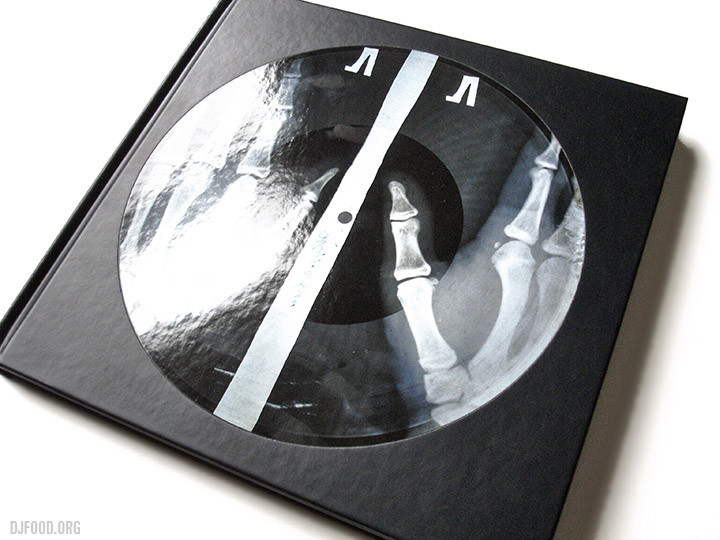
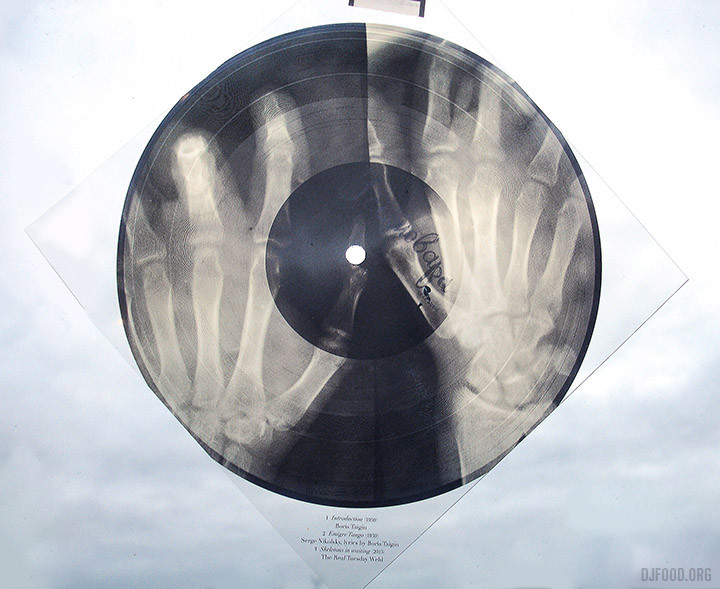
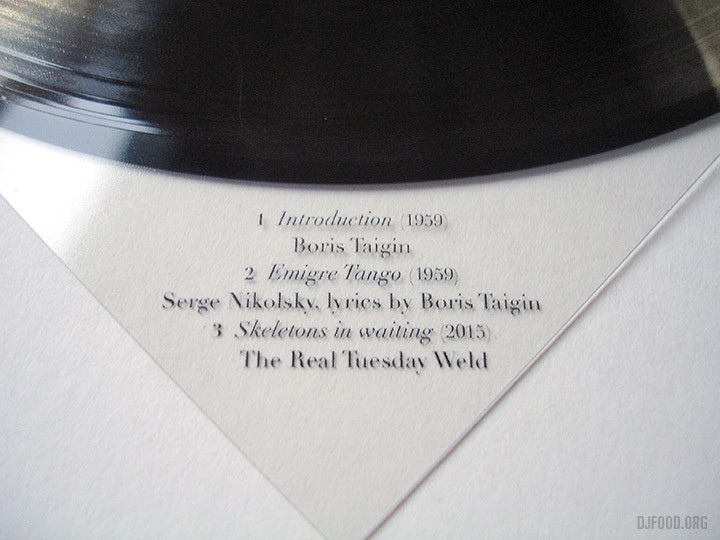
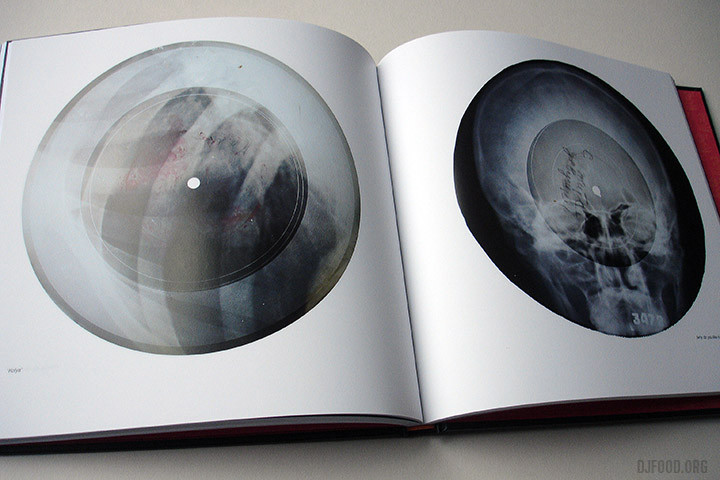
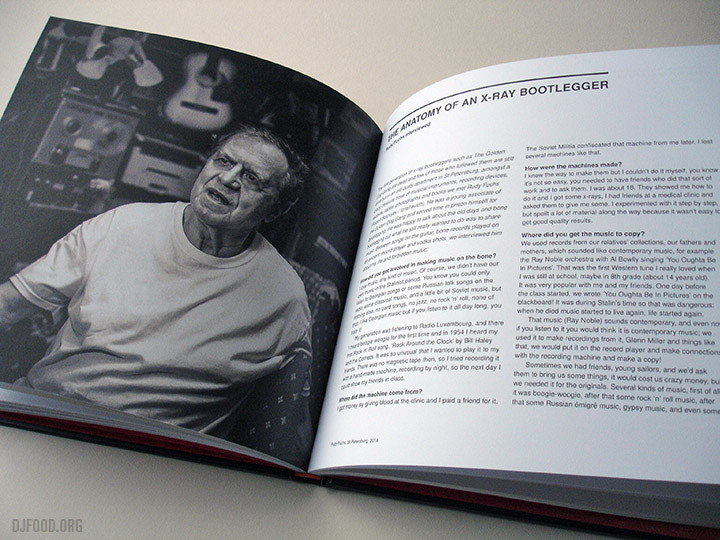
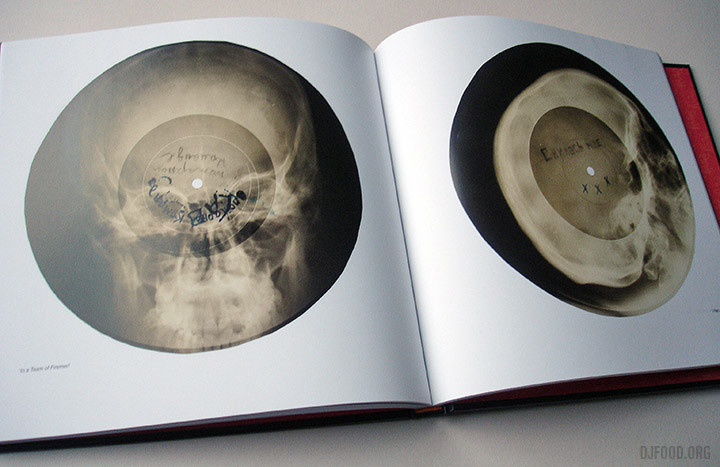
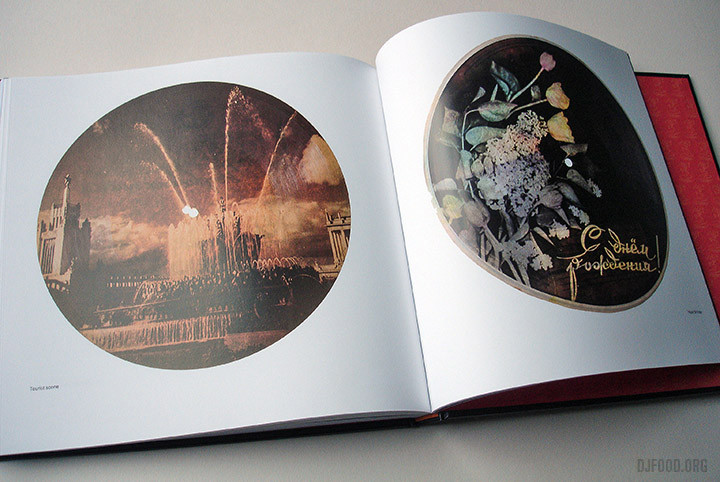

ORDER NOW to reserve one of a special Limited Edition of 500 copies with flexidisc insert containing original Soviet bootleg Bone music and a specially recorded exclusive track by The Real Tuesday Weld
In the cold war era, the Soviet recording industry and permissible musical repertoire were ruthlessly controlled by the State. But a secret and risky subculture of bootleg recordings arose. Incredibly, bootleggers built homemade recording machines and found an extraordinary way to copy banned gramophone records – they used X-Rays clandestinely obtained from hospitals
X-Ray Audio: The Strange Story of Soviet Music on the Bone tells the secret history of these ghostly records and of the people who made, bought and sold them. Lavishly illustrated with images of discs collected in Russia, it is a unique story of forbidden culture, bootleg technology and human endeavour. Contributions from Russian musical commentators and interviews, including one with the last bootlegger standing, set the scene for the intersection of ideological, technological and historical events that created this brief Samizdat musical culture.
In a time when songs can be copied in an instant and when streaming services provide virtually infinite choice and access, X-Ray Audio provides a poignant reminder of the immense cultural value of music and the extraordinary lengths people to which people will go to listen to what they love.
EDITED BY
Stephen Coates
CONTRIBUTORS:
Paul Heartfield
Maksim Kravchinsky
Sukhdev Sandhu
INTERVIEWEES:
Artyemi Troistsky, Aleks Kolkowski, Rudy Fuchs, Kolya Vasin
BIRMINGHAM BONE SHOW
The X-Ray Audio exhibtion is currently at Vivid Projects in Birmingham. We made several new pieces for the show including two new films - one an interview with bone bootlegger cut with archive material and one en ephemeral piece illustrating the process of making an x-ray record.
The show runs until 21st December - details HERE
This Friday 13th we will be hosting a live events with a very special guest - Nick and Christian from The Leisure Society - Aleks will cut a n x-ray record live from their performance.
Go HERE for details
We will be back at London's The Horse Hospital from 28th November - 21st December
In the meantime, enjoy these images from the show courtesy of GREG MILNER
THE SOUND OF BONE
We routinely talk about the sound of bones records being pretty poor. It is clear from testimony from the 1940s and 1950s that they could often sound terrible - even when new. The quality would mainly be affected by the skill of the bootlegger and the lathe they were using. As the practice spread and the opportunity to make money from bone business grew, more unscrupulous dealers got involved and the quality dropped - particularly when deals were conducted anonymously rather than between people who knew each other.
So I was very surprised recently when I met collector Victor Dubiler in Moscow and we played some of his bone records. Check out this film to see why.
The sound quality is amazing - Bill Haley and Elvis are really kicking - and that is when they are just coming out of Victor's small speaker. I don't think you could tell much difference between this bootleg and the original records. This a double sided bone too - and that is very rare - I have only come across one other before. The plastic that this is cut on may in fact not be an undeveloped X-ray at all but another type of film. Victor thought it may be the film that was used for aerial photography. We have heard about this but have not come across it before - and assumed it hadn't been used much because of the difficulty of getting hold of it or the risk of getting caught with it - or perhaps because it didn't sound very good.
The last is definitely NOT the case if this is such film - even if this is a record that has miraculously survived unplayed for all these years.
TED TALK: X-RAY AUDIO
At TED in Krakow in June 2015, Stephen presented the X-Ray Audio project, telling the story of the Soviet bootleggers, bone music and asking the question: "What would you risk to listen to music?"

